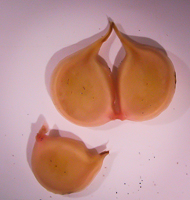ABSTRACT
The germination of seeds in aquaria and posterior planting in the sea is an approach that may be applied in seagrass restoration projects. Hypo-salinity is known to induce germination of Cymodocea nodosa but the appropriate period for seed collection is useful information that has not been considered until now.
The aim of this study was to evaluate the maturity of C. nodosa seeds by comparing the effectiveness of the hypo-salinity induction of germination in seeds collected in August, September and February and detect possible differences in the development of the seedlings. None of the seeds collected in August germinated after hypo-salinity induction and died during the following months of storage in aquaria.
The September and February seeds showed high germination percentage after hypo-salinity induction (> 90 %) and most of them develop into seedlings that showed similar vegetative development. germina- tion of seeds under full salinity was much slower and scarce (less than 15 % after six months). It was feasible to produce well-developed seedlings of C. nodosa with 3-4 leaves and 2 roots with- in five weeks from seeds collected from September to February.









